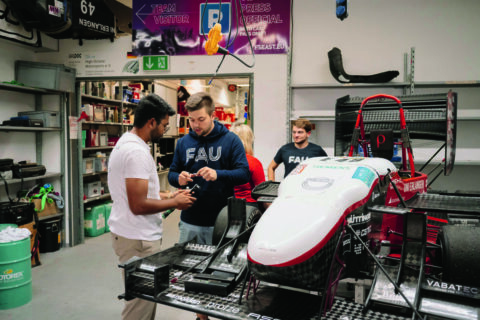Need for Speed
At High-Voltage Motorsports e.V., everything revolves around high speeds and precision, as students develop their own racing cars in the club’s workshop in Tennenlohe.
High-Voltage – at FAU this does not stand for the first album by Australian rock band AC/DC, although it does have something to do with electricity. In the Formula Student Club with the same name, FAU students develop racing cars together. Students founded the association in 2007 under the name “High-Octane Motorsports e.V.”. Until 2021, these were combustion cars, but since then they have focused exclusively on electric vehicles. “The name change to “High-Voltage Motorsports e.V.” was the logical consequence after the switch,” says club director Ferdinand Wurm. “This is also our response to the changes in the automotive industry,” says club chairman Ferdinand Wurm. “In addition, participation in Formula Student Germany has only been possible with purely electric vehicles since 2024.”
Distributed tasks
Developing and building a racing car is a complex process. Many factors have to be taken into account to ensure that a vehicle like the latest version with the type designation “FAUmax rho” can compete on the world’s racetracks. “All the fun begins after the end of the racing season in September,” explains team leader Paul Burkholz. “We will design the new racing car by the end of the year and then build it by the rollout date in early summer.”
In order to work as efficiently as possible, the High-Voltage team is divided into several sub-teams that take care of different tasks. In total, there are six technical sub-teams for the different assemblies on the car, consisting of the manager and his team, such as the “Aerodynamics” sub-team, which Ferdinand Wurm was in charge of in the 2023/24 season, or the “Chassis” sub-team under the leadership of Paul Burkholz.
In addition to the technical teams, there are three other sub-teams responsible for the organization of the club and the static disciplines “Cost & Manufacturing” and “Business Plan”. In total, around 50 to 60 students work together each season, spending an average of two years in the association. The students come from different courses at FAU, such as mechanical or electrical engineering, but also from fields such as economics or cultural geography.
FAU Innovation Award 2024
However, High-Voltage does not develop its racing cars from scratch every season, but adopts concepts and design features that have proven themselves in previous vehicles. Nevertheless, the students are constantly working on improvements to their racing cars. They either have the necessary components manufactured by external companies or build them directly in their own workshop. “We have complicated individual parts in particular, for example for the chassis, which have to be turned or milled, manufactured externally,” explains Paul Burkholz. “Other parts, such as the bodywork made from carbon laminate or the wiring harness for the electronics, we make ourselves in our workshop.”
The association, which is entirely student-run, is financed by sponsors. While FAU and others provide High-Voltage with financial support, some companies support the project with in-kind contributions such as 3D printed parts, milling and turning work or software licenses. “But we can also access equipment and knowledge at some chairs, for example to carry out material tests,” says Paul Burkholz. When the team heads back out onto the racetrack in the summer, they will have a few exhausting months of design work and many test drives behind them.
High-Voltage Motorsports e.V. receives the FAU Innovator Award 2024 in the Students category for their tireless work and the continuous development of their racing cars.
This article has been published as part of the FAU Magazine. More information and content about “Formula Student” can be found here.
Author: Boris Mijat
